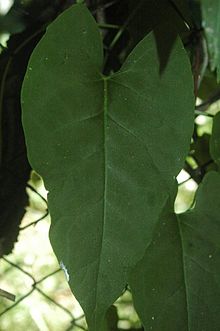Reynoutria multiflora (syn. Fallopia multiflora and Polygonum multiflorum) is a species of flowering plant in the buckwheat family Polygonaceae[1] native to central and southern China.[2][3] It is known by the English common names tuber fleeceflower[4] and Chinese (climbing) knotweed. It is known as he shou wu in China and East Asia.[5] Another name for the species is fo-ti,[6][7][8] which is a misnomer.[9]
| Reynoutria multiflora | |
|---|---|

| |
| Chinese knotweed | |
| Scientific classification | |
| Kingdom: | Plantae |
| Clade: | Tracheophytes |
| Clade: | Angiosperms |
| Clade: | Eudicots |
| Order: | Caryophyllales |
| Family: | Polygonaceae |
| Genus: | Reynoutria |
| Species: |
R. multiflora
|
| Binomial name | |
| Reynoutria multiflora | |
| Synonyms[1] | |
| |
It can be difficult to prevent the spread of this vining plant and to remove it once established. The leaves are thin and fragile but the stems, although narrow in diameter, can be very strong.
Reynoutria multiflora is a herbaceous perennial vine growing to 2–4 m (6 ft 7 in – 13 ft 1 in) tall from a woody tuber. The leaves are 3–7 cm (1.2–2.8 in) long and 2–5 cm (0.79–1.97 in) broad, broad arrowhead-shaped, with an entire margin. The flowers are 6–7 mm (0.24–0.28 in) diameter, white or greenish-white, produced on short, dense panicles up to 10–20 cm (3.9–7.9 in) long in summer to mid autumn. The fruit is an achene 2.5–3 mm (0.098–0.118 in) long.[2]
Reynoutria multiflora is listed in the Chinese Pharmacopoeia and is one of the most popular perennial traditional Chinese medicines. Caution must be taken, however, as overconsumption can lead to toxicity-induced hepatitis.[10]
More than 100 chemical compounds have been isolated from Reynoutria multiflora, and the major components have been determined to be stilbenes, quinones, flavonoids, and others.[citation needed] Its extract contains a stilbene glycoside.[11] [12]